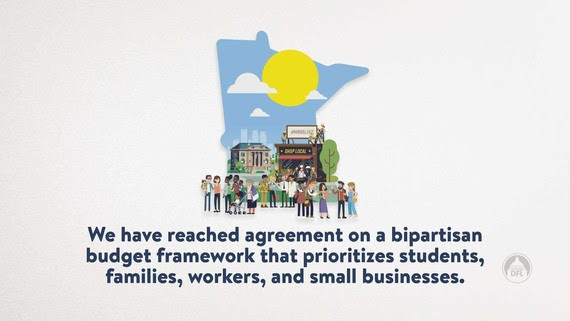|
Dear neighbors,
House DFLers reached a budget agreement with Senate Republicans and Governor Walz today! After weeks of hard work, we have a framework for the two-year budget in place. I’m happy to report it makes strong investments in education and contains enough funding to make significant progress in several areas. We’ll continue negotiating and iron out the details over the next few weeks.

The bipartisan agreement, which you can view here, includes a series of “budget targets.” Each one represents the amount of funds dedicated to an area of the budget. For example, the budget includes $30 million of one-time money for Minnesota’s environment and natural resources. Legislators from the House and Senate will keep working together to determine how the funds for each area will be used. We’re also working on important bills that don’t require funding, like a policy that allows cities to protect pollinators by prohibiting the use of certain pesticides.
Under the agreement, the legislature and the governor will both have a say in how the state utilizes $2.8 billion of federal COVID-19 relief funds. $75 million will be used to provide summer learning opportunities for Minnesota students, and $12 million will support continued operations at the Minnesota Zoo.
I’ll continue advocating for a budget that prioritizes students, families, workers, and small businesses and gives all Minnesotans the support they need to thrive. Please stay tuned for updates.
Helping Communities Deal with Emerald Ash Borer
Communities across the metropolitan area are dealing with infestations of emerald ash borer, an invasive species of beetle that kills ash trees. Each year, cities, counties, and businesses have to cut down more trees to stop it from spreading and to protect residents and their property. As a result, the amount of tree waste produced in Minnesota is steadily increasing. This year, infected trees are expected to generate 265,000 tons of waste wood.
On Saturday, the House passed my bill to help handle tree waste, which ensures communities continue to have a safe way to dispose of their waste wood. The bipartisan bill, which passed with a 87 – 46 vote, allows communities to transport tree waste to a St. Paul plant that uses it as a fuel source and sells some of the electricity it produces to Xcel Energy. You can read more about it here.
I planted a black walnut tree this weekend.
Redistricting Begins in Minnesota
Minnesota’s legislative districts are redrawn every ten years to reflect population changes. As people move, die, or are born, the boundaries of our state's 67 districts shrink or expand so they contain approximately the same amount of people. The goal is to make sure everyone has equal representation in local, state, and federal government.
Legislators kicked off the redistricting process this weekend. The House Redistricting Committee met on Saturday to hear an overview of the latest Census data and discuss the challenging task ahead of them – drawing a fair and balanced map that reflects the geographic, racial, and economic diversity of Minnesota. You can read more about the public hearing and the redistricting process here.
Please feel free to contact me if you have any questions or feedback. It’s an honor to serve you in the Legislature.
Sincerely,
Rick Hansen
State Representative
|